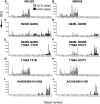Enhanced Human-Type Receptor Binding by Ferret-Transmissible H5N1 with a K193T Mutation
- PMID: 29491160
- PMCID: PMC5923085
- DOI: 10.1128/JVI.02016-17
Enhanced Human-Type Receptor Binding by Ferret-Transmissible H5N1 with a K193T Mutation
Abstract
All human influenza pandemics have originated from avian influenza viruses. Although multiple changes are needed for an avian virus to be able to transmit between humans, binding to human-type receptors is essential. Several research groups have reported mutations in H5N1 viruses that exhibit specificity for human-type receptors and promote respiratory droplet transmission between ferrets. Upon detailed analysis, we have found that these mutants exhibit significant differences in fine receptor specificity compared to human H1N1 and H3N2 and retain avian-type receptor binding. We have recently shown that human influenza viruses preferentially bind to α2-6-sialylated branched N-linked glycans, where the sialic acids on each branch can bind to receptor sites on two protomers of the same hemagglutinin (HA) trimer. In this binding mode, the glycan projects over the 190 helix at the top of the receptor-binding pocket, which in H5N1 would create a stearic clash with lysine at position 193. Thus, we hypothesized that a K193T mutation would improve binding to branched N-linked receptors. Indeed, the addition of the K193T mutation to the H5 HA of a respiratory-droplet-transmissible virus dramatically improves both binding to human trachea epithelial cells and specificity for extended α2-6-sialylated N-linked glycans recognized by human influenza viruses.IMPORTANCE Infections by avian H5N1 viruses are associated with a high mortality rate in several species, including humans. Fortunately, H5N1 viruses do not transmit between humans because they do not bind to human-type receptors. In 2012, three seminal papers have shown how these viruses can be engineered to transmit between ferrets, the human model for influenza virus infection. Receptor binding, among others, was changed, and the viruses now bind to human-type receptors. Receptor specificity was still markedly different compared to that of human influenza viruses. Here we report an additional mutation in ferret-transmissible H5N1 that increases human-type receptor binding. K193T seems to be a common receptor specificity determinant, as it increases human-type receptor binding in multiple subtypes. The K193T mutation can now be used as a marker during surveillance of emerging viruses to assess potential pandemic risk.
Keywords: H5N1; N-linked glycan; glycan array; influenza; receptor binding; sialic acid.
Copyright © 2018 American Society for Microbiology.
Figures





Similar articles
-
Recent H3N2 Viruses Have Evolved Specificity for Extended, Branched Human-type Receptors, Conferring Potential for Increased Avidity.Cell Host Microbe. 2017 Jan 11;21(1):23-34. doi: 10.1016/j.chom.2016.11.004. Epub 2016 Dec 22. Cell Host Microbe. 2017. PMID: 28017661 Free PMC article.
-
Experimental adaptation of an influenza H5 HA confers respiratory droplet transmission to a reassortant H5 HA/H1N1 virus in ferrets.Nature. 2012 May 2;486(7403):420-8. doi: 10.1038/nature10831. Nature. 2012. PMID: 22722205 Free PMC article.
-
Tropism and Infectivity of a Seasonal A(H1N1) and a Highly Pathogenic Avian A(H5N1) Influenza Virus in Primary Differentiated Ferret Nasal Epithelial Cell Cultures.J Virol. 2019 May 1;93(10):e00080-19. doi: 10.1128/JVI.00080-19. Print 2019 May 15. J Virol. 2019. PMID: 30814288 Free PMC article.
-
Adaptation of influenza viruses to human airway receptors.J Biol Chem. 2021 Jan-Jun;296:100017. doi: 10.1074/jbc.REV120.013309. Epub 2020 Nov 22. J Biol Chem. 2021. PMID: 33144323 Free PMC article. Review.
-
H5N1 receptor specificity as a factor in pandemic risk.Virus Res. 2013 Dec 5;178(1):99-113. doi: 10.1016/j.virusres.2013.02.015. Epub 2013 Apr 22. Virus Res. 2013. PMID: 23619279 Free PMC article. Review.
Cited by
-
Molecular Markers and Mechanisms of Influenza A Virus Cross-Species Transmission and New Host Adaptation.Viruses. 2024 May 30;16(6):883. doi: 10.3390/v16060883. Viruses. 2024. PMID: 38932174 Free PMC article. Review.
-
Mutation S110L of H1N1 Influenza Virus Hemagglutinin: A Potent Determinant of Attenuation in the Mouse Model.Front Immunol. 2019 Feb 6;10:132. doi: 10.3389/fimmu.2019.00132. eCollection 2019. Front Immunol. 2019. PMID: 30787926 Free PMC article.
-
Genetic Characterization and Phylogeographic Analysis of the First H13N6 Avian Influenza Virus Isolated from Vega Gull in South Korea.Viruses. 2024 Feb 12;16(2):285. doi: 10.3390/v16020285. Viruses. 2024. PMID: 38400060 Free PMC article.
-
Epitopes in the HA and NA of H5 and H7 avian influenza viruses that are important for antigenic drift.FEMS Microbiol Rev. 2024 May 8;48(3):fuae014. doi: 10.1093/femsre/fuae014. FEMS Microbiol Rev. 2024. PMID: 38734891 Free PMC article. Review.
-
The Q226L mutation can convert a highly pathogenic H5 2.3.4.4e virus to bind human-type receptors.bioRxiv [Preprint]. 2025 Jan 10:2025.01.10.632119. doi: 10.1101/2025.01.10.632119. bioRxiv. 2025. Update in: Proc Natl Acad Sci U S A. 2025 Apr 22;122(16):e2419800122. doi: 10.1073/pnas.2419800122. PMID: 39829928 Free PMC article. Updated. Preprint.
References
-
- Herfst S, Schrauwen EJ, Linster M, Chutinimitkul S, de Wit E, Munster VJ, Sorrell EM, Bestebroer TM, Burke DF, Smith DJ, Rimmelzwaan GF, Osterhaus AD, Fouchier RA. 2012. Airborne transmission of influenza A/H5N1 virus between ferrets. Science 336:1534–1541. doi:10.1126/science.1213362. - DOI - PMC - PubMed
-
- Imai M, Watanabe T, Hatta M, Das SC, Ozawa M, Shinya K, Zhong G, Hanson A, Katsura H, Watanabe S, Li C, Kawakami E, Yamada S, Kiso M, Suzuki Y, Maher EA, Neumann G, Kawaoka Y. 2012. Experimental adaptation of an influenza H5 HA confers respiratory droplet transmission to a reassortant H5 HA/H1N1 virus in ferrets. Nature 486:420–428. doi:10.1038/nature10831. - DOI - PMC - PubMed
Publication types
MeSH terms
Substances
Grants and funding
LinkOut - more resources
Full Text Sources
Other Literature Sources
Medical

